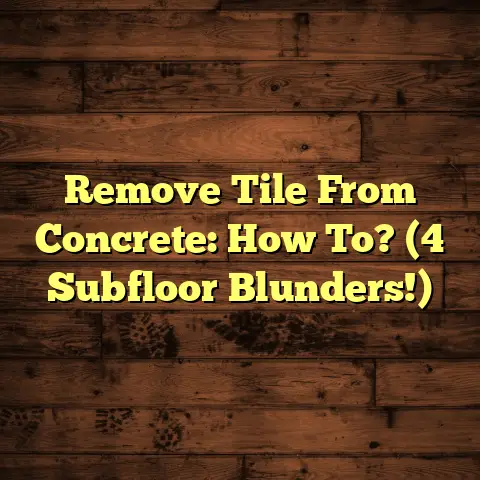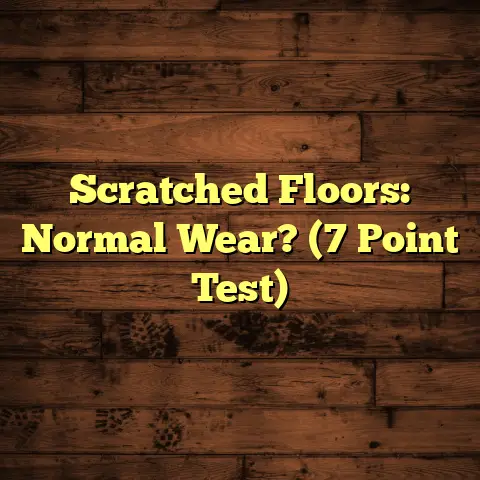Wood-Look Tile: Is It Right? (4 Install Tips)
Isn’t it funny? We all crave that warm, inviting hardwood floor look.
But then we hesitate. Scratches? Water damage? Maintenance?
Suddenly, wood-look tile starts sounding really good.
It’s like we want the idea of wood, but without any of the actual… wood.
Almost as if the floor has feelings and prefers to remain pristine in the face of spilled juice and muddy paws.
Introduction: The Rise of Faux Wood
Wood-look tile has exploded in popularity, and for good reason. It offers a compelling blend of aesthetics and practicality.
It captures the beauty of wood grain and textures, while providing the durability and easy maintenance of tile.
But can it really replicate the charm of real hardwood? That’s the million-dollar question, isn’t it?
I’ve seen some incredible installations, and some that… well, let’s just say they missed the mark.
The key, as I’ve learned over years of flooring, is in the installation.
In this article, I’ll break down everything you need to know about wood-look tile.
We’ll cover if it’s right for you and, most importantly, I’ll share four critical installation tips to ensure a flawless finish.
Section 1: Understanding Wood-Look Tile
So, what exactly is wood-look tile?
Simply put, it’s tile designed to mimic the appearance of natural wood.
It’s typically made from either ceramic or porcelain, with porcelain being the more durable and water-resistant option.
The magic happens with high-definition printing technology.
Manufacturers use this technology to reproduce realistic wood grain patterns, textures, and even knots on the tile surface.
Styles and Designs
The variety is astounding! You can find wood-look tile that replicates:
- Oak
- Maple
- Walnut
- Hickory
- Even exotic wood species.
Colors range from light and airy blonde tones to rich, dark browns and grays.
You’ll also find different plank sizes, widths, and edge treatments (like beveled edges) to further enhance the realism.
Wood-Look Tile vs. Hardwood: The Benefits
Here’s where wood-look tile really shines. Compared to traditional hardwood, it offers:
-
Superior Water Resistance: Perfect for bathrooms, kitchens, and basements.
-
Scratch Resistance: Ideal for homes with pets or high foot traffic.
-
Easy Maintenance: No need for special cleaners or refinishing.
-
Durability: Lasts for decades with proper care.
-
Cost-Effectiveness: Wood-look tile is often more affordable than real hardwood.
Section 2: Assessing If Wood-Look Tile Is Right for Your Space
Now, let’s get down to brass tacks. Is wood-look tile the right choice for your home? It depends.
The Case For and Against
Kitchens: A resounding YES! Wood-look tile can handle spills and splashes without warping or staining.
Bathrooms: Another win! Its water resistance makes it a far better choice than hardwood.
Living Rooms: Here, it’s a bit more nuanced. Wood-look tile can create a stylish and durable living space.
But some people find it lacks the warmth and softness of real wood underfoot.
Bedrooms: Many homeowners prefer the coziness of carpet or hardwood in bedrooms, but wood-look tile can work well, especially in warmer climates.
Design Aesthetics
Wood-look tile is incredibly versatile. It can complement a wide range of design styles, including:
-
Modern: Clean lines and minimalist decor pair well with light-colored, straight-laid wood-look tile.
-
Rustic: Embrace the warmth and character of darker wood tones and distressed textures.
-
Farmhouse: Opt for wider planks with subtle variations in color and grain.
-
Coastal: Choose light, whitewashed wood-look tile to create a breezy, beachy vibe.
Keep in mind, the quality of the tile and the installation are crucial for achieving the desired look.
A poorly installed tile will detract from any design aesthetic.
Scenarios Where Wood-Look Tile Shines
-
High-Traffic Areas: Hallways, entryways, and mudrooms are perfect candidates for wood-look tile.
-
Homes with Pets: Say goodbye to scratches and stains!
-
Homes with Kids: Easy to clean up spills and messes.
-
Basements: Moisture-resistant and durable, making it ideal for basements.
Section 3: The Importance of Installation
I can’t stress this enough: Installation is EVERYTHING!
Even the most beautiful, high-end wood-look tile can look cheap and unconvincing if it’s not installed correctly.
I’ve seen stunning tiles ruined by:
- Uneven grout lines
- Misaligned planks
- Poorly prepared subfloors
These mistakes can detract from the overall appearance and even lead to structural issues down the road.
Common Installation Mistakes
-
Skipping Subfloor Prep: This is a HUGE mistake! A level, clean subfloor is essential.
-
Using the Wrong Adhesive: Different tiles require different adhesives.
-
Poor Layout Planning: Randomly laying tiles can result in an unnatural look.
-
Inconsistent Grout Lines: Uneven grout lines are a dead giveaway that it’s not real wood.
-
Neglecting Expansion Joints: Failing to account for expansion and contraction can lead to cracking.
Setting the Stage for Success
The following four installation tips are designed to help you avoid these common mistakes and achieve a professional, wood-like finish.
Trust me, taking the time to do it right will pay off in the long run!
Section 4: Install Tip #1 – Preparing the Subfloor
Your subfloor is the foundation of your entire flooring project.
If it’s not properly prepared, your wood-look tile will be doomed from the start.
A well-prepared subfloor ensures:
-
A Level Surface: Prevents uneven tiles and tripping hazards.
-
Proper Adhesion: Allows the adhesive to bond effectively.
-
Longevity: Extends the life of your tile floor.
Assessing the Subfloor
Before you even think about laying tile, carefully inspect your subfloor. Look for:
-
Cracks: Repair any cracks with a concrete patching compound.
-
Loose Boards: Secure any loose plywood or OSB with screws.
-
Uneven Areas: Use a self-leveling compound to smooth out any dips or bumps.
-
Moisture: Moisture is the enemy! Use a moisture meter to check the moisture content of the subfloor.
Ideally, it should be below 3%.
If it’s too high, address the source of the moisture before proceeding.
Cleaning the Subfloor
Once you’ve made any necessary repairs, thoroughly clean the subfloor.
Remove any:
- Dust
- Dirt
- Debris
- Old Adhesive
I recommend using a shop vacuum followed by a damp mop with a mild detergent.
Allow the subfloor to dry completely before moving on to the next step.
Leveling the Subfloor
A level subfloor is crucial for preventing uneven tiles and ensuring a professional- looking installation.
Use a long level (at least 6 feet) to check for any high or low spots.
If you find any significant variations, use a self-leveling compound to create a smooth, even surface.
Follow the manufacturer’s instructions carefully when applying the self-leveling compound.
Moisture Testing
As I mentioned earlier, moisture is a major concern when installing tile.
Excessive moisture can cause the adhesive to fail, leading to loose tiles and even mold growth.
Use a moisture meter to test the moisture content of the subfloor.
If the moisture level is too high, you’ll need to address the source of the moisture before proceeding.
You may need to install a moisture barrier to prevent moisture from seeping up from below.
Section 5: Install Tip #2 – Choosing the Right Adhesive
Selecting the right adhesive is just as important as preparing the subfloor.
The adhesive is what holds your tile in place, so you need to choose one that’s compatible with both the tile and the subfloor.
Types of Adhesives
There are several types of adhesives available for installing wood-look tile, including:
-
Thin-Set Mortar: This is the most common type of adhesive for tile installation. It’s a mixture of cement, sand, and polymers.
-
Modified Thin-Set Mortar: This type of mortar contains additional polymers that improve its bonding strength and flexibility.
-
Epoxy Mortar: Epoxy mortar is a two- part adhesive that’s extremely strong and water-resistant. It’s often used in commercial applications or in areas subject to heavy moisture.
-
Pre-Mixed Mastics: These are convenient, pre-mixed adhesives that are easy to apply. However, they’re not as strong or durable as thin-set mortars.
Factors to Consider
When choosing an adhesive, consider the following factors:
-
Tile Type: Porcelain tile requires a stronger adhesive than ceramic tile.
-
Subfloor Material: Some adhesives are better suited for concrete subfloors, while others are better for plywood.
-
Installation Environment: If you’re installing tile in a wet area, choose a water-resistant adhesive.
-
Tile Size: Larger tiles require a stronger adhesive.
Recommendations
For most wood-look tile installations, I recommend using a modified thin-set mortar.
It provides a strong, durable bond and is compatible with both ceramic and porcelain tile.
If you’re installing tile in a wet area, choose a modified thin-set mortar that’s specifically designed for wet environments.
Application Techniques
Proper application is key to ensuring a strong bond. Follow these tips:
-
Use the Right Trowel: The size and shape of the trowel notches will determine how much adhesive is applied.
Use a trowel size recommended by the adhesive manufacturer.
-
Apply Evenly: Spread the adhesive evenly over the subfloor, using a consistent pressure.
-
Comb the Adhesive: Use the notched edge of the trowel to comb the adhesive, creating ridges that will help the tile grip.
-
Don’t Overwork the Adhesive: Apply the tile within the adhesive’s open time (the amount of time it remains workable).
If the adhesive starts to skin over, remove it and apply fresh adhesive.
Section 6: Install Tip #3 – Layout Planning
This is where the magic happens! A well- planned layout can make all the difference in achieving a natural, wood-like appearance.
Why Layout Planning Matters
-
Minimizes Waste: Careful planning reduces the amount of tile you’ll need to cut.
-
Creates a Balanced Look: Avoids awkward cuts and ensures a visually appealing pattern.
-
Enhances Realism: Mimics the way real wood floors are installed.
Laying Patterns
There are several laying patterns you can use with wood-look tile, including:
-
Straight Lay: This is the simplest pattern, with the tiles laid in straight rows. It’s a good choice for modern spaces.
-
Staggered Lay (Brick Pattern): This pattern creates a more traditional look, with the tiles staggered by a half or a third of their length.
-
Herringbone: This pattern creates a zigzag effect, adding visual interest to the floor. It’s a more challenging pattern to install, but the results are stunning.
-
Random Lay: This pattern involves laying the tiles in a random pattern, with varying lengths and widths. It’s a good choice for creating a rustic or eclectic look.
Measuring and Marking
Before you start laying tile, take the time to measure and mark your layout.
-
Find the Center: Determine the center of the room and mark it with a chalk line.
-
Dry-Fit the Tiles: Lay out a row of tiles along the chalk line to see how they fit.
Adjust the layout as needed to minimize cuts and ensure a balanced look.
-
Mark the Layout: Use a pencil or chalk to mark the layout on the subfloor.
Indicate the position of each tile and any cuts that need to be made.
-
Consider Expansion Joints: Leave a small gap (about 1/4 inch) around the perimeter of the room to allow for expansion and contraction.
Section 7: Install Tip #4 – Grouting and Finishing Touches
Grouting is the final step in the tile installation process.
It fills the gaps between the tiles, creating a smooth, seamless surface.
Finishing touches, like edge trim and transitions, add the final polish to your new floor.
Choosing the Right Grout
The color and type of grout you choose can have a significant impact on the overall appearance of your floor.
-
Grout Color: Choose a grout color that complements the tile and your design aesthetic.
Lighter grout colors will make the tiles stand out, while darker grout colors will create a more subtle look.
You can also choose a grout color that matches the tile to create a seamless effect.
-
Grout Type: There are several types of grout available, including:
-
Sanded Grout: This type of grout contains sand, which makes it more durable and resistant to cracking. It’s a good choice for wider grout lines.
-
Unsanded Grout: This type of grout is smoother and easier to work with. It’s a good choice for narrow grout lines.
-
Epoxy Grout: This type of grout is extremely strong and water-resistant. It’s often used in commercial applications or in areas subject to heavy moisture.
-
Grouting Process
-
Apply the Grout: Use a grout float to apply the grout to the tile surface.
Work the grout into the grout lines, making sure to fill them completely.
-
Remove Excess Grout: Use the grout float to remove any excess grout from the tile surface.
Hold the float at a 45-degree angle and scrape it across the tile surface.
-
Clean the Tile: Use a damp sponge to clean the tile surface, removing any remaining grout haze.
Rinse the sponge frequently and avoid using too much water.
-
Cure the Grout: Allow the grout to cure for the amount of time recommended by the manufacturer.
This will allow the grout to harden and reach its full strength.
Sealing the Grout
Sealing the grout lines will help protect them from stains and moisture.
Apply a grout sealer according to the manufacturer’s instructions.
Reapply the sealer every year or two to maintain its effectiveness.
Finishing Touches
-
Edge Trim: Install edge trim around the perimeter of the room to create a clean, finished look.
Choose a trim that complements the tile and your design aesthetic.
-
Transitions: Use transitions to smoothly connect the tile floor to other flooring types, such as carpet or hardwood.
Conclusion: Your Wood-Look Tile Journey
Wood-look tile offers a fantastic combination of beauty and practicality.
By understanding the nuances of the material and following these four essential installation tips, you can achieve a stunning floor that rivals the look of real hardwood.
Remember, proper subfloor preparation, adhesive selection, layout planning, and grouting are all critical for success.
Take your time, pay attention to detail, and don’t be afraid to ask for help if you need it.
With a little effort, you can create a beautiful and durable floor that you’ll enjoy for years to come.
So, is wood-look tile right for you? Weigh your options, consider your needs, and let these tips guide you toward a stylish and satisfying home environment.





